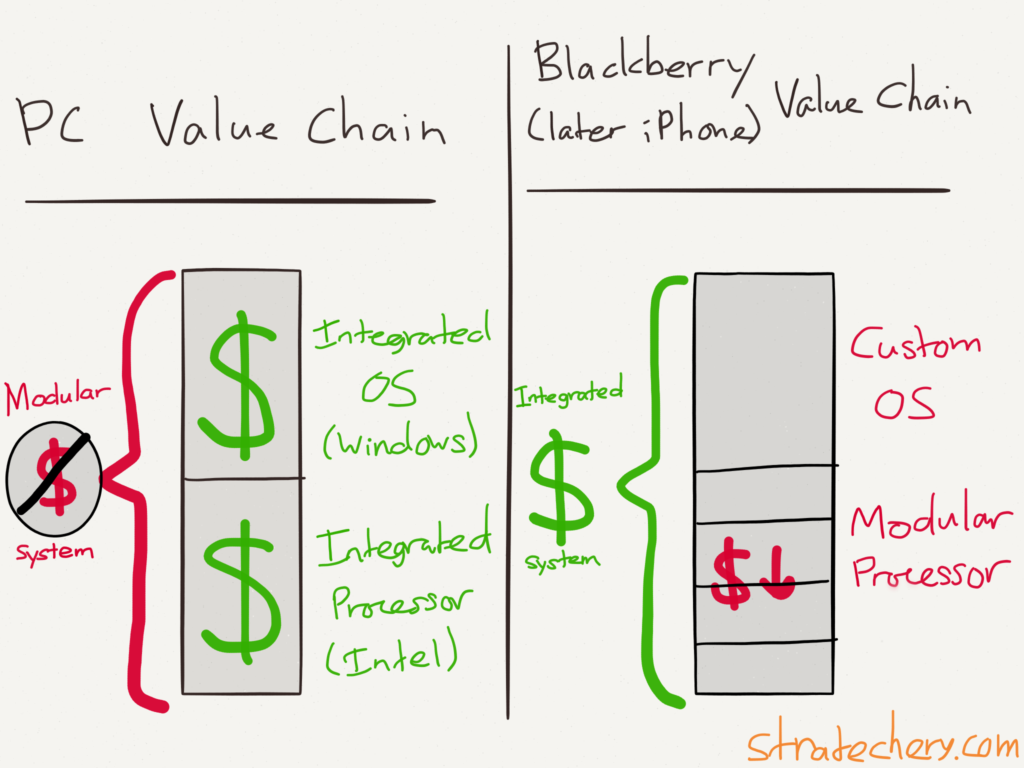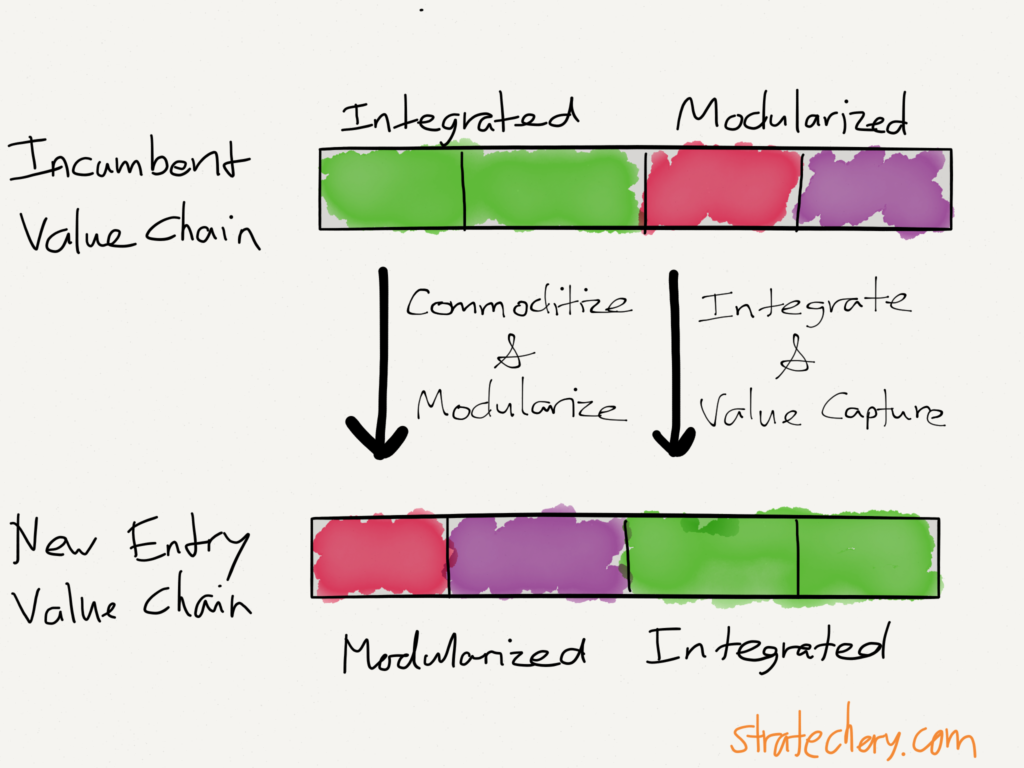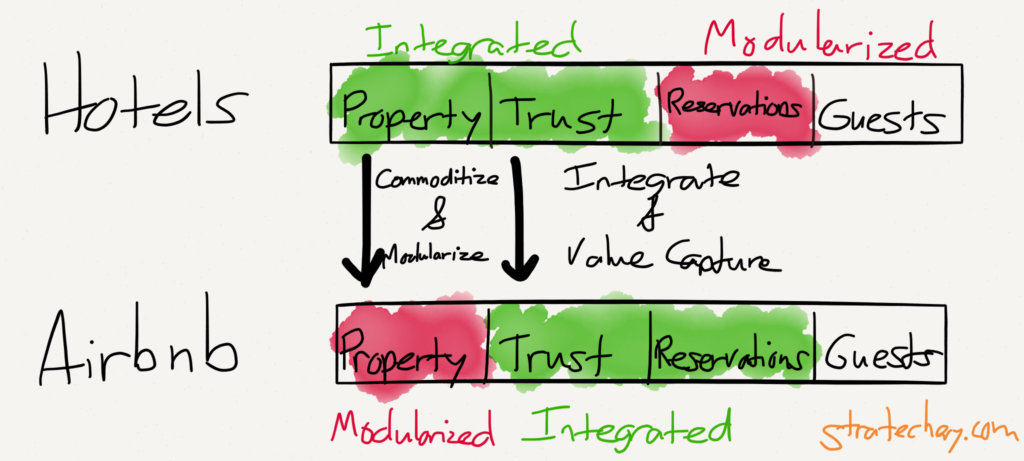Netflix and the Conservation of Attractive Profits
Netflix and the Conservation of Attractive Profits
Two years ago, when I first wrote about TV and how it had resisted disruption , I called Netflix “just another network”:
Netflix famously pivoted from DVDs-by-mail to streaming, but that was only pivot number one. Pivot number two was their transformation from a content delivery provider to simply another network.
Think about it: Netflix invests millions of dollars in new TV shows to drive growth, and has reruns and old movies as filler. They’re HBO with a unique delivery system. Or, to fit the analogy [of networks as VCs for television shows], Netflix is just another VC, with a war chest built by a completely different business (the aforementioned discs-by-mail). Netflix is unique, but ultimately uninteresting, and unlikely to be replicated.
I got this one wrong, and in a big way.
Why Netflix Isn’t a Network
The “Netflix as a network” framing was the basis of an attention-getting article in Variety headlined Netflix U.S. Viewing to Surpass ABC, CBS, Fox and NBC by 2016 :
If Netflix were a Nielsen-rated TV network, the No. 1 streaming service would, within a year, attain a larger 24-hour audience than each of the major broadcast networks — ABC, CBS, Fox and NBC — according to a Wall Street analyst firm.
To be clear, the analysis by FBR Capital Markets is not apples-to-apples. One major caveat: Nielsen TV ratings cover, at most, up to seven days of VOD and DVR viewing — and exclude online-video views, which networks say are an increasing part of the pie. Moreover, TV networks provide a different blend of content, such as live sports, that Netflix doesn’t. And anyway, Netflix doesn’t care about “ratings” of individual shows, given that it doesn’t sell ads and has steadfastly refused to disclose anything but general data about viewing.
Actually, the degree to which this is a valid comparison is very much open to debate. On one hand, any time spent watching Netflix is time not spent watching traditional TV. Moreover, Netflix is increasingly competing against traditional networks for content. On the other hand, as the excerpt notes, Netflix relies on subscriptions, not ads, which means it is much less concerned with the number of viewers for a particular show within a particular time frame.
Still, even this last point of differentiation is less stark than it seems. As I noted in Old-Fashioned Snapchat , network revenue has seen a significant shift over the last several years from advertising to affiliate revenue in particular; it turns out that a little bit of money from every cable subscriber is much more profitable, predictable, and sustainable than attempting to wrangle a massive audience to sell to advertisers in an increasingly fractured media environment. This shift also changed the type of TV that mattered: instead of the sort of lowest common denominator fare that characterized the first several decades of TV, it’s far more important to have “must-see” shows and events, even if the number of people for whom said shows and events are must-see is relatively small; all that matters is that these fans base their pay-TV subscription decision on access to said shows and events. 1 This reality — that networks were just as reliant on (another sort of) subscription revenue as Netflix — is what led to my conclusion that Netflix was “HBO with a unique delivery system.”
That last piece though — the non-linearity of Netflix’s programming — is more important than I realized, for a reason I articulated last week in Airbnb and the Internet Revolution :
The commoditization of trust is far more injurious to hotels than you might think…In the pre-Airbnb days travelers — and sublessors — justifiably prioritized trust above all else. In other words, the implication of Airbnb building a platform of trust is not that a homestay is now more trustworthy than a hotel; rather, it’s that the trust advantage of a hotel has been neutralized, allowing homestays to compete on new vectors, including convenience, cost, and environmental factors.
What is revolutionary about on-demand streaming in general and Netflix in particular is that the service has commoditized time: on Netflix Sunday at 9pm is no different than Tuesday at 11am or Friday at 6pm; there is no prime time. Thus Netflix will release original series all at once, because why not? Best to maximize the number of minutes over which an expensive upfront cost like producing a show can be utilized.
For what it’s worth, I’m actually not certain this strategy is optimal for any one given show: I suspect there is a lot of value in the “buzz” created around appointment viewing, live Twitter reactions, and day-after write-ups. On the other hand, Netflix’s absolute embrace of the commoditization of time sends an important message to both content creators and content consumers that the service is first and foremost committed to connecting each side of the content equation as efficiently as possible.
The Law of Conservation of Attractive Profits
When you think about it that way — that Netflix isn’t so much a network as they are a type of marketplace in which consumers can give their attention to creators — it becomes apparent that Netflix isn’t that far off from Uber or Airbnb or any of the other market-makers that are transforming industry-after-industry. Netflix:
- Is an infinitely scalable network…
- That has commoditized a previous constraint and…
- Positioned itself to be the chief beneficiary of industry transformation.
I made this an ordered list on purpose: these three characteristics work in concert to create value due to something called the Law of Conservation of Attractive Profits, 2 first explained by Clayton Christensen in his 2003 book The Innovator’s Solution :
Formally, the law of conservation of attractive profits states that in the value chain there is a requisite juxtaposition of modular and interdependent architectures, and of reciprocal processes of commoditization and de-commoditization, that exists in order to optimize the performance of what is not good enough. The law states that when modularity and commoditization cause attractive profits to disappear at one stage in the value chain, the opportunity to earn attractive profits with proprietary products will usually emerge at an adjacent stage.
That’s a bit of a mouthful, but the example that follows in the book shows how powerful this observation is:
If you think about it in a hardware context, because historically the microprocessor had not been good enough, then its architecture inside was proprietary and optimized and that meant that the computer’s architecture had to be modular and conformable to allow the microprocessor to be optimized. But in a little hand held device like the RIM BlackBerry, it’s the device itself that’s not good enough, and you therefore cannot have a one-size-fits-all Intel processor inside of a BlackBerry, but instead, the processor itself has to be modular and conformable so that it has on it only the functionality that the BlackBerry needs and none of the functionality that it doesn’t need. So again, one side or the other needs to be modular and conformable to optimize what’s not good enough.
Did you catch that? That was Christensen, a full four years before the iPhone, explaining why it was that Intel was doomed in mobile even as ARM would become ascendent. 3 When the basis of competition changed away from pure processor performance to a low-power system the chip architecture needed to switch from being integrated (Intel) to being modular (ARM), the latter enabling an integrated BlackBerry then, and an integrated iPhone four years later. 4

More broadly, breaking up a formerly integrated system — commoditizing and modularizing it — destroys incumbent value while simultaneously allowing a new entrant to integrate a different part of the value chain and thus capture new value.

This is exactly what is happening with Airbnb, Uber, and Netflix too.
How Airbnb, Uber, and Netflix Capture Value
As noted above, I discussed Airbnb last week: the service commoditized trust, divorcing it from the underlying physical property. That freed Airbnb to integrate trust into a worldwide network of hosts and guests:

Uber has a trust element as well (as do nearly all the sharing companies), but even more important was how the service commoditized dispatch and modularized cars:

Netflix has pulled a similar maneuver: by commoditizing time and distribution the company has integrated production and customer management:

(See this follow-up about how I would re-label this chart)
Note the common element to all three of these companies: all have managed to modularize the production/delivery of their service which has allowed them to move closer to the customer. To put it another way, all of this new value is being created by specialized CRM companies: Airbnb for travelers, Uber for commuters, and Netflix for the bored.
I do think I’ve underestimated Netflix, but only to a point; I detailed in The Changing — and Unchanging — Structure of TV that when it comes to the TV value chain it is highly differentiated content creators that retain the most power (in a way that Airbnb hosts and Uber drivers clearly do not 5 ). Moreover, Netflix faces strong competition for attention from both traditional pay-TV as well as Amazon Prime, a revitalized Hulu, and especially HBO.
Netflix’s hit rate is improving, but HBO continues to be must-see TV. This excellent profile of the company in Hollywood Reporter notes:
For all the upstart competitors with their signature shows, conversations with two dozen top producers and their representatives reveal that HBO remains the most desirable place to be — because it has the audience, the budgets, the promotional muscle and, perhaps most important, the most experience turning good ideas into great TV. “Anyone who tells you they want to be somewhere else is lying, or they couldn’t get on the air at HBO,” gripes one top rep, who requested anonymity for fear of offending other buyers. WME’s Emanuel has no such worries. “They’re the creme de la creme, and when you do get on, it’s a big statement that you’re the best,” he says.
This is a big advantage: the best is uniquely important when it comes to the subscription business. Still, you can take integration too far. That same profile notes:
The biggest risk that HBO faces creatively is one of its own making. With more than 100 projects said to be in development, HBO is in constant danger of becoming a victim of its own success — so clogged with talent that the next Lena Dunham or David Chase will go elsewhere…this bottleneck is the chief criticism of the network.
Competitors, including Netflix and Amazon, are preying on those turned off by the lengthy queue at HBO, aggressively touting their willingness to move quickly and slap shows on the air. That swiftness is said to have been the key to Netflix, rather than HBO, landing Kyle Chandler’s Bloodline and the upcoming mind-bender The OA from Brit Marling.
This is the freedom that comes from being a new entrant: it’s not only that Netflix is integrated around the customer experience, it’s that they’re modularized around the content creation as well; this too is why the Uber employee lawsuits are a real risk. Integrated profits are the yin to modularization efficiencies’ yang, and the most promising companies are the ones that create the biggest breaks with the past.
- Every single sports fan is looking at their cable bill and nodding wearily at the realization they are the ones who have made ESPN the most profitable network of all [ ↩ ]
- Later renamed the Law of Conservation of Modularity [ ↩ ]
- I have my differences with Christensen , but as I’ve said repeatedly my criticism comes from an attempt to build on his brilliant work, not tear it down [ ↩ ]
- As I’ve noted , the iPhone is in fact modular at the component level; the integration is between the completed phone and the software. Not appreciating that the point of integration (or modularity) can be anywhere in the value chain is, I believe, at the root of a lot of mistaken analysis about the iPhone in particular [ ↩ ]
- By the way, note that when/if Uber has self-driving cars, they will be fully integrated [ ↩ ]
文章版权归原作者所有。
